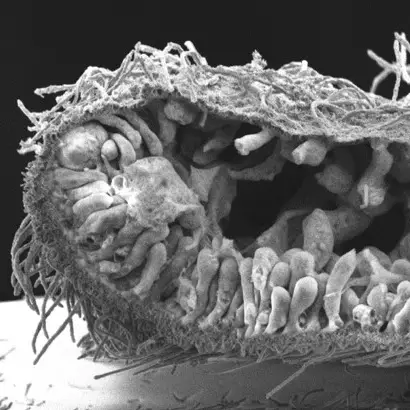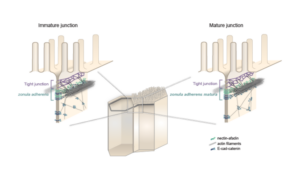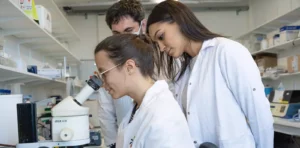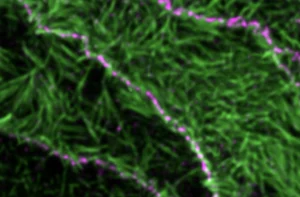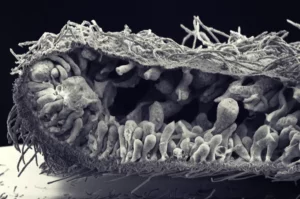Evolution and Morphogenesis of Epithelia
Our team investigates the origin and evolution of the defining features of epithelial tissues (intercellular junctions, apico-basal polarity, basement membrane) and the biomechanical cues that control them.
Publications
Super-resolution imaging uncovers the nanoscopic segregation of polarity proteins in epithelia
Evolution of mechanisms controlling epithelial morphogenesis across animals: new insights from dissociation-reaggregation experiments in the sponge Oscarella lobularis
New genomic data and analyses challenge the traditional vision of animal epithelium evolution
The elmo-mbc complex and rhogap19d couple Rho family GTPases during mesenchymal-to-epithelial-like transitions
Crumbs, Moesin and Yurt regulate junctional stability and dynamics for a proper morphogenesis of the Drosophila pupal wing epithelium.
Role of the crumbs proteins in ciliogenesis, cell migration and actin organization
Crb3 is required to organize the apical domain of multiciliated cells
Super-resolution imaging uncovers the nanoscopic segregation of polarity proteins in epithelia
Evolution of mechanisms controlling epithelial morphogenesis across animals: new insights from dissociation-reaggregation experiments in the sponge Oscarella lobularis
New genomic data and analyses challenge the traditional vision of animal epithelium evolution
The elmo-mbc complex and rhogap19d couple Rho family GTPases during mesenchymal-to-epithelial-like transitions
Crumbs, Moesin and Yurt regulate junctional stability and dynamics for a proper morphogenesis of the Drosophila pupal wing epithelium.
Animal multicellularity and polarity without Wnt signaling.
Role of the crumbs proteins in ciliogenesis, cell migration and actin organization
Binding of ZO-1 to α5β1 integrins regulates the mechanical properties of α5β1-fibronectin links.
Quantitative methods to study epithelial morphogenesis and polarity
The PCP pathway regulates Baz planar distribution in epithelial cells.
Hook2, a microtubule-binding protein, interacts with Par6α and controls centrosome orientation during polarized cell migration
P-cadherin-mediated Rho GTPase regulation during collective cell migration.
The localisation of the apical Par/Cdc42 polarity module is specifically affected in microvillus inclusion disease.
Segmentation and Quantitative Analysis of Epithelial Tissues.
Draft Genome Sequence of an Alphaproteobacterium Associated with the Mediterranean Sponge Oscarella lobularis.
Mitochondrial Genome Sequence of the Glass Sponge Oopsacas minuta.
The Crumbs3 complex
CRB2 acts as a modifying factor of CRB1-related retinal dystrophies in mice.
Drebrin E depletion in human intestinal epithelial cells mimics Rab8a loss of function.
Targeted Ablation of Crumbs1 and Crumbs2 in Retinal Progenitor Cells Mimics Leber Congenital Amaurosis.
The multi-PDZ domain protein-1 (MUPP-1) expression regulates cellular levels of the PALS-1/PATJ polarity complex.
Primary cilium migration depends on G-protein signalling control of subapical cytoskeleton.
Evolution and Cell Physiology. 4. Why invent yet another protein complex to build junctions in epithelial cells?
Loss of CRB2 in the mouse retina mimics human retinitis pigmentosa due to mutations in the CRB1 gene.
News
Lenne and Le Bivic teams show that intestinal adherens junctions are very different from the textbook picture.
Join the IBDM for your internship!
Seeking for your Master internship? The IBDM seems like the right place to do it? Check out our offers.
Organizing the organizers
Andrea Pasini, in the Le Bivic’s team, has recently been awarded a grant from the CNRS Programme ‘Diversity of Biological Mechanisms’, to study the epithelial plasticity of Trichoplax.
7 IBDM teams have received grants from ANR
7 IBDM teams have received grants from the Agence Nationale pour la Recherche (ANR) in 2021. Congratulations to Vincent Bertrand, Harold Cremer, Pascale Durbec, André Le Bivic, Pierre-François
We are looking for candidates wishing to apply to a CENTURI Program PhD fellowship to work on the cell biology of epithelia in the emerging model Trichoplax.
Interplay of cellular forces, adhesion and mechanics during colorectal cancer progression
The intern will develop skills in cell biology (cell culture, immunofluorescence, confocal imaging) and will be trained to use advanced biophysical tools (deformable hydrogel beads, atomic force microscopy).
Sensing mechanical forces during epithelial remodeling in the Placozoan Trichoplax adhaerens
The M1 student will learn micromanipulation, live confocal imaging, immunofluorescence and quantitative modelling techniques.
Applicants should be interested in the quantitative aspects of cell biology, with a particular focus on marine organisms.
Wanted! Highly motivated candidates wishing to apply for an Aix-Marseille University PhD fellowship to work on the cell biology of epithelia in the emerging model Trichoplax adhaerens. On cherche des candidat-e-s à une bourse doctorale de Aix-Marseille Université pour étudier la biologie des épithéliums dans un organisme-modèle émergeant, Trichoplax adhaerens.











